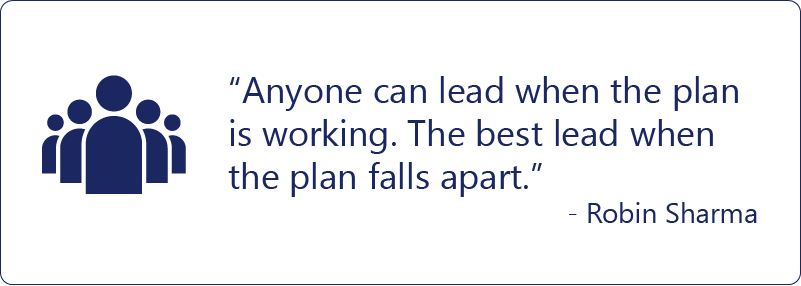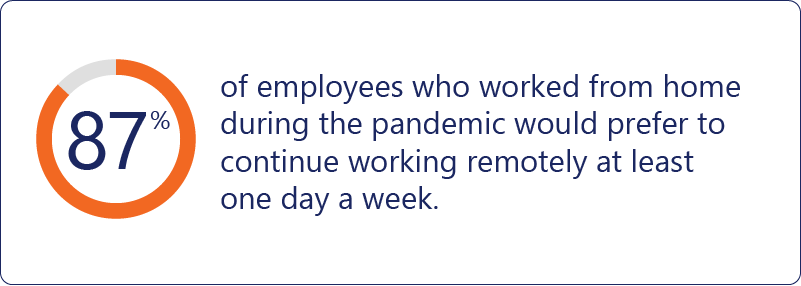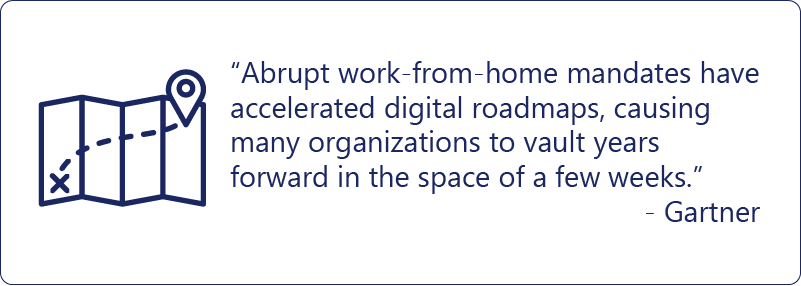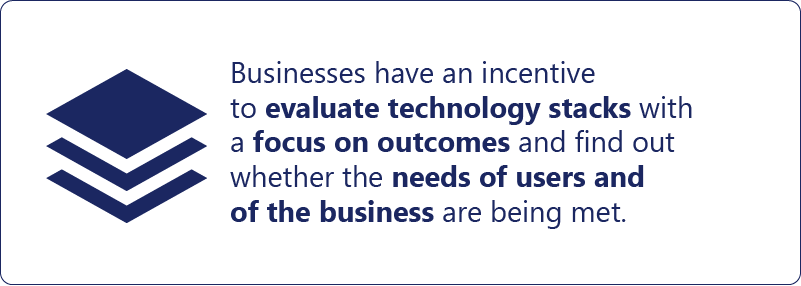7-minute read
5 ways businesses can leverage change management to succeed as a post-pandemic organization to emerge stronger, more resilient, and better prepared for whatever the future holds
When the Covid-19 pandemic struck with full force in Spring 2020, few businesses realized at the time that they were facing what investors call a “black swan” event: a sudden, unpredictable occurrence with far-reaching and long-lasting repercussions. Change management teams went into overdrive just to keep pace with an environment that seemed to shape-shift daily, if not hourly, and the continuous flow of change kept coming. A year and a half later, we’re still not out of the woods, but we can begin looking towards the future and shaping our organizations. To succeed in a post-pandemic business world, change management is essential.
Even if we never see another pandemic during our lifetimes (we certainly hope not!), disruptions are a fact of business life, and the events of the last 18 months amounted to a master class in dealing with dramatic, unexpected change. In this article, we’ll explore five ways businesses can apply change management best practices to emerge from the Covid crisis stronger, more resilient, and better prepared for whatever the future holds.
1. Make empathy a core value
We would challenge you to find a company out there that doesn’t claim to value people, and most of them honestly do. What Covid made abundantly clear is that, while productivity, processes, and technology are all vitally important, at the end of the day every business really is about people—the employees, the customers, the partners, and others that enable the organization to do what it does—and that means empathy must take top priority, especially during times of stress and uncertainty.
Change affects each person differently, and each person responds to change in their own way and at their own pace. The Kübler-Ross Change Curve, rooted in the well-known five stages of grief, offers a useful illustration of the journey that individuals go through when faced with sudden disruptions:

By demonstrating empathy at every stage of the journey, organizations can make people feel heard, valued, and appreciated, which can only make the company stronger.
2. Redefine effective leadership
Leadership expert Robin Sharma once wrote, “Anyone can lead when the plan is working. The best lead when the plan falls apart.” Sometimes it takes a crisis like the Covid pandemic to separate the great leaders from the good leaders, and the good leaders from … well, those who may be better suited for a different role.
It’s a well-known adage that people don’t leave companies—they leave leaders. Now that the Covid recession is easing and companies are hiring again, employees who may be disappointed in their leadership are free to look elsewhere, and many are. In a March 2021 study, 26 percent of employees surveyed indicated they planned to look for a new job when the threat of the pandemic subsided.

For organizations looking to the future, this is an ideal time to take stock and re-evaluate their perspective on what makes a good leader. Some are taking the opportunity to ask their employees how they feel about the support they received (or did not receive) during the pandemic and what their leadership could have done better. The learnings from these evaluations can drive improvements to both hiring and promotion policies, helping ensure that future leaders have the skills and the emotional intelligence to lead their teams during times of crisis.
Another lesson we can take away from the Covid experience is that all leaders need at least a basic education around change management principles. When out-of-left-field disruptions happen, leaders at each level have the clearest perspective on how their teams will be affected and what they will need to move forward. A basic knowledge of change management best practices will help leaders better understand the role they play in helping the team deal with uncertainty and make better decisions on a day-to-day basis.
3. Adapt to the full impact of workplace changes
By forcing widespread adoption of remote work to slow the spread of the virus, the pandemic let the proverbial work-from-home genie out of the bottle. Businesses who swore they would never entertain remote work as an option were presented with undeniable proof that it could work for them, and employees had solid grounds for demanding more flexible work options. In the March 2021 survey referenced above, 87 percent of employees who worked from home during the pandemic said they would prefer to continue working remotely at least one day a week; among all responders, 68 percent said a hybrid workplace model is ideal.

Now that Covid-driven remote work policies have been around for a while—and are likely to continue in some form—organizations are realizing the less obvious ramifications of the new workplace and the need to adapt in multiple areas. One example is career development: Are employees who work mostly on-site more likely to be promoted than those who work mostly remotely? In making these decisions, leaders will have to take into account “presence versus passion” and ensure that remote employees have access to the same opportunities as their on-site colleagues—and to reassure their teams accordingly.
4. Embrace newfound resilience
Let’s face it: we’re human beings, and human beings as a whole aren’t huge fans of change (part of the reason why we need good change managers :-)). One thing Covid has done is present us with a huge proof-of-concept concerning change itself: organizations proved to their people that they can go through dramatic changes in a short time span and come out just fine on the other side.
We believe this experience will embolden organizations to enact changes more readily and more assertively than they have in the past (but always with sensitivity to the well-being of their people—see our discussion on empathy above). In the area of digital transformation, for example, Gartner has pointed out that “[a]brupt work-from-home mandates have accelerated digital roadmaps, causing many organizations to vault years forward in the space of a few weeks.” Similar statements could also be made about HR policies, workplace operations, customer service, and a host of other areas deeply impacted by the sudden demands of the pandemic.

Expect to see long-delayed and possibly even “mothballed” changes, along with some new innovations, to make their way to the front burner in many organizations, with the attitude of “We proved just how agile we can be in responding to Covid, so let’s try this and see what happens.” And when things don’t work out as expected, leaders will need to show humility and honesty in admitting “This didn’t work, here’s why, and here’s what we learned in the process.” This can be a scary place for some leaders to go, so it’s essential to make sure the organization’s culture will support them.
5. Assess technology stacks
Reliance on technology skyrocketed in many organizations with the onset of Covid: Microsoft now has 145 million daily users of its Teams app (up from 32 million at the start of lockdowns), and Zoom users are now racking up 3.3 trillion meeting minutes each year. On the customer service side, businesses turned to technologies such as real-time call transcription and virtual agents to deal with soaring call volumes in the early days of the pandemic, most of which continued to deliver positive ROI even after demand had stabilized.

This is another area where organizations can take the opportunity to assess and adjust. All too often, technology decisions are made based on haphazard criteria and solutions implemented with fingers firmly crossed. In normal times, this may not be a problem, but when the Covid pandemic changed everything, “good enough” was no longer good enough. Businesses now have a strong incentive to evaluate their technology stacks with a focus on outcomes and ask whether the needs of users and of the business are being met. If certain platforms are requiring elaborate workarounds—or being avoided altogether—some tech housecleaning may be in order, and an effective change management strategy can help ensure adoption of new platforms at all levels.
As the post-Covid business environment begins to take shape, we’re likely to see organizational changes becoming the rule instead of the exception—and a greater need for change management expertise. Here at Logic20/20, clients in multiple industries have come to us for help in creating momentum behind some exciting new initiatives. If you have any questions about how to move your organization forward into this strange, exciting, and sometimes scary new world, feel free to reach out—we’d love to chat with you.
Like what you see?

Tennille Gruman is a change manager at Logic20/20 with 14+ years of diverse experience in the retail, legal, agricultural, and hospitality industries and a passion for people, culture, and technology adoption.

Ragini McKenna is a seasoned management consultant with over 10 years of experience and a focus on people and change management, strategy, and process improvement across a range of industries.

